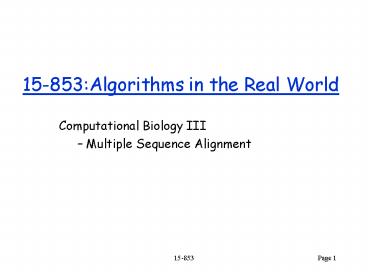15-853:Algorithms in the Real World - PowerPoint PPT Presentation
Title:
15-853:Algorithms in the Real World
Description:
Title: 15-499: Algorithms and Applications Author: Guy Blelloch Last modified by: Guy Blelloch Created Date: 9/8/1999 5:39:44 AM Document presentation format – PowerPoint PPT presentation
Number of Views:126
Avg rating:3.0/5.0
Title: 15-853:Algorithms in the Real World
1
15-853Algorithms in the Real World
- Computational Biology III
- Multiple Sequence Alignment
2
Multiple Alignment
- A C T _ G T A
- A C A C G T T
- A G T G _ T A
- C C _ G C T A
- Goal match the maximum number of aligned pairs
of symbols. - Applications
- Assembling multiple noisy reads of fragments of
sequences - Finding a canonical among members of a family and
studying how the members differ - The problem is NP-hard
3
Example Output
- Output from typical multiple alignment software
- DNAMAN (using ClustalW)
4
Scoring Multiple Alignments
- Distance from consensus Sc
- Pairwise distances
- Evolutionary Tree Alignment
5
Approaches
- Dynamic programming optimal, but takes time that
is exponential in p - Center Star Method approximation
- Clustering Methods also called iterative
pairwise alignment. Typically an
approximation.Many variants, many software
packages
6
Using Dynamic Programming
- For p sequences of length n we can fill in a
p-dimensional array in np time and space. - For example for p 3
- where
- assuming the pairwise distance metric.
- Takes time exponential in p. Perhaps OK for p
3
7 cases
7
Example
8
Optimization
- As in the case of pairwise alignment we can view
the array as a graph and find shortest paths. - Used in a program called MSA.
- Can align 6 strings consisting of 200 bp each in
a practical amount of time.
9
Center Star Method
- Find St 2 S minimizing
- Add remaining sequences S/St one by one so
alignment of each is optimal wrt St.Add spaces
if needed - Time O(p2n2)
S1
S2
S3
S4
S5
10
Using Clustering
- Compute D(Si,Sj) for all pairs
- Bottom up cluster
- All sequences start as their own cluster
- Repeat
- find the two closest clusters and join them
into one - Find best alignment of the two clusters being
joined
11
Distances between Clusters
actg_a attg_a actgga
D?
_accca aaccga
- Could use difference between consensus.
- A popular technique is called the Unweighted
Pair-Group Method using arithmetic Averages
(UPGMA).It takes the average of all distances
among the two clusters. - Implemented in Clustal and Pileup
12
Summary of Matching
- Types of matching
- Global align two sequences A and B
- Local align A with any part of B
- Multiple align k sequences (NP-complete)
- Cost models
- LCS and MED
- Scoring matrices Blosum, PAM
- Gap cost affine, general
- Methods
- Dynamic programming many optimizations
- Fingerprinting hashing of small seqs.
(approx.) - Clustering for multiple alignment (approx.)































